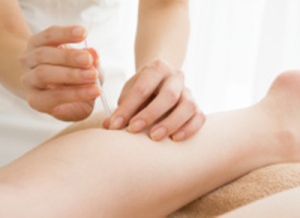 Dry needling has become a popular treatment modality today in physical therapy, and has proven to be one of the most effective treatment options with the management of musculoskeletal injuries and pathologies. As a podiatrist we use this treatment in addition to traditional modalities due to its extensive benefits and applications in the lower limb.
Dry needling has become a popular treatment modality today in physical therapy, and has proven to be one of the most effective treatment options with the management of musculoskeletal injuries and pathologies. As a podiatrist we use this treatment in addition to traditional modalities due to its extensive benefits and applications in the lower limb.
In this blog post, we wanted to address some of the most common questions we receive from patients about dry needling.
What is it?
Dry needling is the use of acupuncture needles to break down muscle ‘knots’, otherwise known as myofascial trigger points. With the use of this unique technique, we can specifically target dysfunctional tissues to improving tissue healing, and restoration of muscle function.
With the use of a fine filament needle, it penetrates the skin with little to no discomfort, and can begin to release the trigger point allowing blood flow to come back into the site of injury.
How does it work?
The exact mechanisms of dry needling are quite complex. With the use of a very fine filament into the site, it sends injury signals to the brain, initiating a sequence of events to replace or repair the damaged tissue with healthy tissue. By needling in a painful trigger point, it can elicit a local twitch response which reduces the concentration of biochemicals in the body responsible for pain and inflammation around the site of pain/injury. In addition, this local twitch response also increases the release of the body’s own pain relieving chemicals within the brain providing an analgesic effect to the patient.
What is the difference between dry needling and acupuncture?
Although dry needling uses acupuncture needles, it does not follow an East Asian Medicine approach which is based on ancient theories of Chinese medicine. Modern dry needling is performed by a trained physical therapist using modern scientific research of the musculoskeletal and nervous systems.
Does it hurt?
Everyone reacts differently to dry needling, however, if the muscle is sensitive, shortened, or has an active trigger point within, a sensation similar to a muscle cramp will be experienced (the “twitch” response).
General soreness can be expected after the treatment, however will depend on the individual, as well as the intensity of the treatment provided.
Is it safe?
With dry needling, there are very few known side effects apart from post treatment soreness and possible bruising. However if the practitioner does not prepare the skin properly, there is an increased chance of infection.
At Holistic Foot Clinic, we prepare the skin with alcohol wipes, and allow it to dry, therefore preventing the chances of infection from the treatment.
Where does it fit into my rehabilitation?
- Tendinopathies, in particular achilles tendinopathy
- Plantar heel pain
- Ankle sprains and peroneal pain
- “Shin splints” otherwise known as medial tibial stress syndrome
- Tibialis posterior pain
- Forefoot pain
- Knee pain
- Prehabilitation – otherwise known as being proactive in avoiding pain and injury.
Want to know more?
If you have any further questions or feel Dry Needling may help you please call or book online: https://holisticfootclinic.com.au/booking

